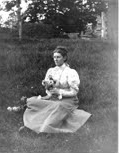 News release from the Milton Historical Society
News release from the Milton Historical Society
There is a new display in Milton History Room located on the 2nd floor of the Milton Public Library that includes some of Margaret Sutermeister’s photographs and 3 historical maps.
1826 plan of Neponset Village; 1912 map of Milton commissioned by Nathaniel Kidder for Milton’s 250th anniversary; and a map prepared in 1937 by Milton Women’s Club showing Milton during period from 1630-1780 as described in Teel’s History of Milton.
In the collection of the Milton historical Society there is a special cache of more than 1,800 glass negatives spanning about 15 years from1894 to 1909 taken by Margaret Sutermeister. In 1894 Margaret turned 19 years of age and would have left school by this time and she, along with a number of other Victorian women, found artistic expression with a wonderful new device – the camera.
Margaret’s photographs illustrate a very exciting and changing period of time in both Milton and throughout the country. It was a time when new inventions were changing both the landscape and life styles. The camera was the invention that captured Margaret’s attention. With camera in hand, she soon became a familiar figure around town. Margaret sought to photograph everyone she came in contact with from formal portraits and candid shots. Her sensitive portraits range from the middle-class and wealthy families in Milton and their homes and churches to African Americans, Gypsy peddlers, farmhands and Asian laundrymen. Her landscapes capture a romantic feeling and are also a testament to her skill. She documented scientific experiments, the world of the future and the disappearing world of horse-drawn carriages on dirt roads. She was a sensitive and curious observer of her world. Margaret was very enthusiastic about her work. A story is told that when her house was on fire, she ran outside with her camera to record the event instead of helping to extinguish the flames!
When her father died suddenly in 1909, Margaret put her camera away and assumed the management of the family Davenport Nursery. Within days of his death, Margaret applied to the district court to become administrator of his estate. The energy which she had brought to her photographic work would now be channeled into managing the family’s floral nursery and taking care of her mother and three maiden aunts who lived in the Sutermeister/Davenport home. “Daisy”, as she was known, was now referred to by her fellow townspeople as “The Flower Lady”.
In 1951, a year after her death, the new owners of the house where Margaret lived all her life came across a calico covered crate in the barn adjacent to the house. It contained 1,800 glass negatives stored in groups of 10 in the original boxes, hand-numbered from ”First” to “One—hundred and eighty-second.” The William Rusts family presented this treasure to the Milton Historical Society.
In the early 1990s art historian Judith Bookbinder came to the Milton Historical Society in search of visual material for an exhibition that she was curating on the history of southeastern Massachusetts. When shown the Sutermeister collection, she was impressed with the quality of the portraits and landscapes. She saw Sutermeister as an artist, an accomplished photographer during the formative years of this medium. With the support of the Milton Historical Society Bookbinder curated an exhibition of Surtermeister’s work featuring 53 images. They were first exhibited in March-April 1993 at the Milton High School Art Gallery. Over the next 15 months exhibits were held at Milton Academy Nesto Gallery, Commonwealth Museum at Massachusetts State Archives, Duke’s County Museum on Martha’s Vineyard and Radcliffe College Schlesinger Library.
This exhibition will be shown again in parts over the coming months. A few of the photographs on display now are “Boy in a rowboat framed by Paul’s Bridge” and “The Gypsy Peddler” which was taken outside the Sutermeiser house. The April 11, 1891 issue of THE MILTON NEWS reported “The frequent appearance of hand organs, hurdygurdys and gypsys on the streets are a sign of blooming spring”.